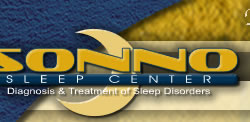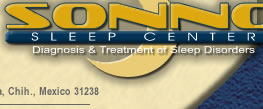They
may age more quickly and are at higher risk for accidents,
in the car and at work.
Adequate sleep is essential for good health. For most adults that means an average
of eight hours of sleep each night, although a small number of people may need
a bit more or less.
There is a variety of sleep disorders. Some are very common and some are very
rare. Not all sleep problems are the result of a sleep disorder. Some difficulties
may be related to medical or psychological illnesses, medications, stress or
pain.
One of the most common
sleep disorders in adults is obstructive sleep
apnea, occurring in an estimated one in four individuals
over age 60. In this disorder, breathing is impaired or stops for several seconds
repeatedly throughout the night. This disrupts the flow of sleep and can result
in a variety of problems including daytime sleepiness.
Most people who have obstructive sleep apnea also have a history of loud snoring.
Snoring often occurs in individuals with a small or crowded upper airway, which
may be more prone to narrowing or closing off briefly during sleep.
Bedpartners of people with apnea may hear loud snoring followed by a pause in
breathing, a loud snort or gasp and a resumption of snoring.
People with apnea may experience restless sleep, frequent morning headaches,
irritable mood, sexual dysfunction, or unintentional sleep during the day, despite
adequate hours of sleep.
The risk for sleep apnea increases with age, and is seen more often in individuals
who are overweight or who also have breathing difficulties during the day. It
is also more likely to be seen in people who have a small lower jaw, large tonsils
and/or a short, thick neck.
To diagnose sleep apnea, a patient needs to be evaluated by an experienced physician
and should undergo a study called a polysomnogram, typically done overnight in
a sleep laboratory. Patients stay in a special room that allows them to be observed
and has equipment to monitor heart rate, brain waves, breathing rhythm, oxygen
levels, muscle activity, and eye movement. A sleep physician then reviews this
information and helps determine if a sleep disorder is present.
The most effective way to treat sleep apnea is with continuous positive airway
pressure (CPAP) http://www.respironics.com.
This involves the patient wearing a mask over the nose that blows a small amount
of pressurized air, helping keep the upper airway open and eliminating the apnea
and snoring. CPAP allows a patient to sleep better and feel more rested when
used every night.
Other treatments include weight loss, positional therapy, oral appliance therapy
or surgery to alter the structure of the airway.
One other relatively
common disorder is restless legs syndrome.
This disorder is diagnosed based on a history of restlessness or discomfort
predominantly in the legs, and typically occurring in the evening or when a
person sits or lies down for a prolonged period of time. The sensation in the
legs is relieved when that person gets up and/or moves around.
Restless legs syndrome can run in families. It is most common in older adults,
and symptoms tend to increase with age. Symptoms may occur earlier in life, especially
in association with neuropathy, kidney failure, anemia or pregnancy.
Most restless legs syndrome sufferers also have periodic limb movements during
sleep. These are typically noticed by a bedpartner as a "kick" or a "pulling
up" of the leg and foot off and on throughout the night. Some individuals
may experience these movements as part of the aging process and may not have
or develop restless legs symptoms.
The treatment for restless legs syndrome usually involves avoiding behaviors
that may make symptoms worse, such as sleep deprivation and alcohol consumption.
Medications also may be used to treat symptoms in the evenings and during sleep.
| Narcolepsy & REM
sleep behavior disorder |
Narcolepsy and REM
sleep behavior disorder are two sleep disorders that
are much less common and are frequently misunderstood by both physicians
and patients.
Narcolepsy typically does not cause a person to sleep excessively. Most patients
with narcolepsy sleep only 8 to 9 hours in a 24-hour period. This is the normal
sleep requirement for most adults. Instead, people with narcolepsy have difficulty
with regulating transitions between sleep and wakefulness. They may have brief
attacks during the day where they fall asleep without warning and they may have
difficulty staying asleep at night.
Most narcoleptic patients find 5- to 15-minute naps refreshing and can stay awake
without much difficulty for 1 to 2 hours after a nap.
About 60 percent of people with narcolepsy experience spells referred to as cataplexy.
These involve a brief and sudden loss of strength and muscle tone, which may
cause a fall and/or injury. These spells are most often provoked by laughter
or strong emotion. They can be both dangerous and debilitating for people who
experience them. People who experience cataplexy are often embarrassed and frustrated
by the episodes.
Medications are available to reduce the frequency and severity of both sleep
attack and cataplexy. People who think they may have narcolepsy should be promptly
evaluated and tested at a sleep center.
REM sleep behavior disorder occurs most often in older adults and is sometimes
confused with sleep walking. Sleep walking is most common in children and adolescents.
REM sleep behavior disorder results from a loss of the normal paralysis of the
skeletal muscles during dream sleep. People will physically act out parts of
dreams. They are at risk for seriously injuring themselves or their bedpartners.
The exact cause for this disorder is unknown but it is seen more often in people
with Parkinson's disease and a few other degenerative neurological disorders.
REM sleep behavior disorder is treated with medication and by rearranging objects
in the bedroom to improve safety. Diagnosis is usually made following an evaluation
in the doctor's office. Sleep studies may be considered in cases where the diagnosis
is uncertain.
Most people are unaware that the two most common sleep complaints besides snoring
are not usually caused by a sleep disorder. These complaints are insomnia and
daytime sleepiness or fatigue. Insomnia is most often a symptom of another problem.
Its cause can range from something as simple as stress, pain or a certain medication.
Alternatively it may be due to multiple factors, including the sleep environment
or a serious medical or psychiatric illness. The most common cause of daytime
sleepiness is not getting enough sleep on a routine basis, or other poor sleep
habits.
| Narcolepsy & REM
sleep behavior disorder |
PUBLIC
POLICY ON SLEEP DISORDERS:
Approximately 40 million Americans suffer from chronic sleep disorders and another
20 to 30 million suffer intermittent sleep-related problems. Evidence tells us
that America’s sleep debt is on the rise. Yet, numerous studies have concluded
that the general public, policy makers and primary care physicians lack basic
sleep knowledge. More importantly, the vast majority of Americans with sleep
disorders remain undiagnosed and untreated and research is severely lacking.
As a result, the toll on human health, productivity and safety is enormous.
ABOUT THE NATIONAL SLEEP FOUNDATION:
Due to these reasons, the National Sleep Foundation is committed to an advocacy
program with the Legislative and Executive branches of the federal government.
Their mission is to promote public understanding of sleep and sleep disorders
and support education, research and advocacy to improve public health and safety.
One essential way to achieve this mission is to advocate for federal research
and educational initiatives to ensure that all Americans have access to the health
care and knowledge they need to lead healthy, productive lives. Within these
broad goals, they dedicate themselves to a government advocacy program that addresses
the following legislative and regulatory issues.
Should you have any questions about NSF government affairs programs, please call
them at
(202) 347-3471 or visit their website at www.sleepfoundation.org.
|





















